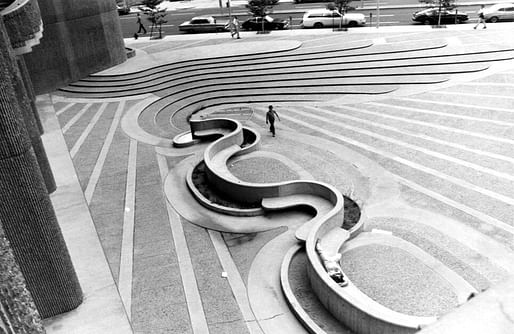
According to a recent article from The Boston Globe, due to city's "hot" real estate market, which has "prompted a number of developers to tear down and build up," the Governor's office now wants to get in on the action.
On Wednesday, the Baker administration unveiled plans to redevelop the state-owned Charles F. Hurley Building, reports the Globe. The efforts will open up a 3.25 acre site with a deal earning the state tens of millions of dollars, "at a minimum." The administration is moving quickly, hoping to identify a developer within 18 to 24 months after putting the project out to bid. Plans are reported to include a new office complex, new ground floor retail, and possible restaurant spaces.
Paul Rudolph began the design process of the brutalist building in 1962 and construction began in 1966, lasting 5 years. Yesterday, The Paul Rudolph Heritage Foundation posted a call-to-action on its website and twitter feed. In a blog post titled, S.O.S: - Save Rudolph's Boston Government Service Center, the Foundation celebrates the work as "one of Rudolph's largest and most multifaceted urban commissions in the US" and encouraged readers to comment on the Globe article advocating for the structure's preservation.
The organization highlights the many facilities housed by the project over the years from education, to health, welfare, unemployment, parking, and other government offices. "The building is a richly conceived composition of plazas, interiors, offices, public spaces, forms, textures, and seating, which was designed to serve many functions," the Foundation writes.

According to the Boston Globe, construction could start as soon as three years from now. They report the state Division of Capital Asset Management and Maintenance expressing an "approach to redeveloping the property that will 'acknowledge the architecturally significant elements of the Hurly-Lindemann site, while addressing its flaws.'" As the news reaches more ears, it will be interesting to see how the ambitions of the Baker administration will be received by preservationists and local residents.
Contemporary with Boston City Hall, which is much better design and makes a clear metaphorical statement about bureaucracy. Rudolph’ building is just ugly.
That being said, adaptive reuse would be a great solution here, infinitely preferred over the wasteful demolition of this building solely to maximize its real estate value.
All 6 Comments
Great news. This building has been hated for a long time. Hopefully they will take their time in designing a sensitive infill and not a developer money grab as is done in NYC regularly.
https://www.fastcompany.com/1594998/bostons-ugliest-buildings-are-surprise-all-brutalist
Design by public opinion. What could possibly go right?
Ignoring public opinion. What could possibly go right?
Your post: 1. State Opinion. 2. State information that seems on the surface to validate your opinion. (without citation or source) 3. Make unrelated comment that provides cover for the first two being basically unfounded opinions.
It’s an o p i n i o n. Get it?
Based on what? An opinion that's pulled dripping wet from one's ass is worth about as much as the rest of one's rectal excretions.
Hidden comments don't mean incorrect comments.
I don't get it.
Contemporary with Boston City Hall, which is much better design and makes a clear metaphorical statement about bureaucracy. Rudolph’ building is just ugly.
That being said, adaptive reuse would be a great solution here, infinitely preferred over the wasteful demolition of this building solely to maximize its real estate value.
Reminds me of the German WW II submarine pens at Lorient, without the French flair.
FOH
Brutal, or Ugly it may be, that, as always and ''the rest of the story'' is always ''in the eye of the beholder.''
What may be more relevant to today's architects is that this design, similar to many others of the ilk, id, etc., is actually quite derivative and formulaic, and does not need to be ''saved'' or ''slaved over'' for any intrinsic reason of the design or designer...
Better IMHO to continue to commission fresh design based on fresh concepts of human health, at all levels, first and foremost, and cost effectiveness and efficiencies of all sorts balanced with budget.
Thank you
The existing building built less than half of what was planned. Part of the site was left open and unfinished for decades. My recollection is that the State of Massachusetts built infill along the open edges of the site in a compatible but undistinguished way. This building must be experienced to be appreciated more than most. Climbing the meandering concrete exterior stair and transitioning form city to interior courtyard through the building is uniquely participatory. This is one of Paul Rudolph's best in terms of use of material and form. It is non-functional at best on the interior. The exterior is in terrible condition, particularly the stair and plaza. Much of the best is along one edge and forms an edge of the Bulfinch triangle with four to five story industrial buildings. The Kallman McKinnel courthouse nearby pays respectful deference to Rudolph's building. The Hurley building is both the best and worst of 1960's urban planning with a contextual edge wrapping an enclosed urban courtyard. The result is a windy and underused plaza that looks good in plan (old Copley?City Hall Plaza?) but not in practice. I hope the best of this building can be saved and repurposed. If we continue to demolish these icons someday there will not be anything left to represent this era. The architects and planners had good intentions that can be recaptured fothe modern city.
Block this user
Are you sure you want to block this user and hide all related comments throughout the site?
Archinect
This is your first comment on Archinect. Your comment will be visible once approved.